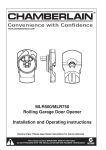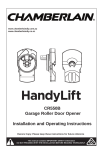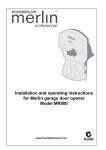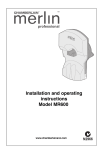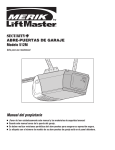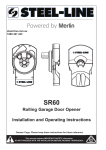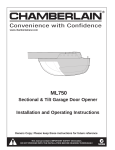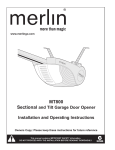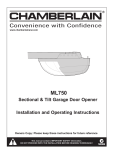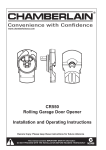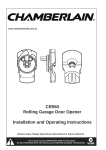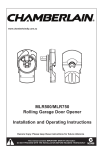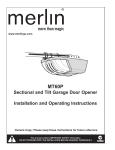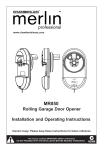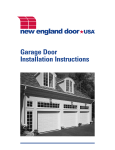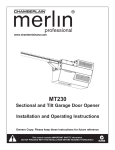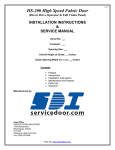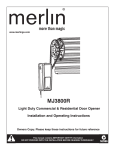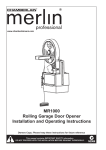Download Rolling Garage Door Opener Installation and Operating Instructions
Transcript
www.chamberlainanz.com MR60 MR60 Rolling Garage Door Opener Installation and Operating Instructions Owners Copy: Please keep these instructions for future reference This manual contains IMPORTANT SAFETY information. DO NOT PROCEED WITH THE INSTALLATION BEFORE READING THOROUGHLY. START BY READING THESE IMPORTANT SAFETY INSTRUCTIONS WARNING • Failure to comply with the following instructions may result in serious personal injury or property damage. • Read and follow all instructions carefully. • The garage door opener is designed and tested to offer safe service provided it is installed and operated in strict accordance with the instructions in this manual. These safety alert symbols mean WARNING : A possible risk to personal safety or property damage exists. Keep garage door balanced. Do not let the garage door opener compensate for a binding or sticking garage door. Sticking, binding or unbalanced doors must be repaired before installing this opener. Do not wear rings, watches or loose clothing while installing or servicing a garage door opener. Frequently examine the door installation, in particular cable, springs and mountings for signs of wear, damage or imbalance. Do not use if repair or adjustment is needed since springs and hardware are under extreme tension and a fault can cause serious personal injury. To avoid serious personal injury from entanglement, remove all ropes, chains and locks connected to the garage door before installing the door opener. Installation and wiring must be in compliance with your local building and electrical codes. The safety reverse system test is very important. Your garage door MUST reverse on contact with a 40mm obstacle placed on the floor. Failure to properly adjust the opener may result in serious personal injury from a closing garage door. Repeat the test once a month and make any necessary adjustments. This opener should not be installed in a damp or wet space exposed to weather. This appliance is not intended for use by persons (including children) with reduced physical, sensory or mental capabilities or lack of experience and knowledge, unless they have been given supervision or instruction concerning use of the appliance by a person responsible for their safety. The opener must not be used on a wicket door (door within a door). The Protector SystemTM must be used for all installations where the closing force as measured on the bottom of the door is over 400N (40kgf). Excessive force will interfere with the proper operation of the safety reverse system or damage the garage door. After installation, ensure that the parts of the door do not extend over public footpaths or roads. Install the wireless wall control (or any additional wall control) in a location where the garage door is visible, at a height of at least 1.5m and out of the reach of children. Do not allow children to operate push button(s) or transmitter(s). Serious personal injury from a closing garage door may result from misuse of the opener. Permanently fasten the Warning Labels in prominent places, adjacent to wall controls and manual release mechanisms as a reminder of safe operating procedures. Activate opener only when the door is in full view, free of obstructions and the opener is properly adjusted. No one should enter or leave the garage while the door is in motion. Do not allow children to play near the door, or door controls. Disconnect electric power to the garage door opener before making repairs or removing covers. KEEP THESE INSTRUCTIONS NOTE: If your garage has no service entrance door, a CM1702 outside quick release must be installed. This accessory allows manual operation of the garage door from outside in case of power failure. CONTENTS PAGE SAFETY INSTRUCTIONS . . . . . . . .1 CARTON INVENTORY . . . . . . . . . .2 TOOLS REQUIRED . . . . . . . . . . . .2 DOOR REQUIREMENTS . . . . . . . .2 PREPARE & TEST THE DOOR . .3-4 INSTALLATION . . . . . . . . . . . . . .5-6 CONNECT ELECTRIC POWER . . .7 ADJUSTMENT . . . . . . . . . . . . . . .7-8 INSTALL THE PROTECTOR SYSTEM .9 WIRELESS PROGRAMMING .10-11 SPECIAL FEATURES . . . . . . . . . .12 ACCESSORIES . . . . . . . . . . . . . . .12 TROUBLESHOOTING . . . . . . . . . .13 OPERATION OF YOUR OPENER 14 CARE OF YOUR OPENER . . . . . .14 MAINTENANCE OF YOUR OPENER 14 SPECIFICATION . . . . . . . . . . . . . .14 WARRANTY . . . . . . . . . . . . . . . . .15 1 1 CARTON INVENTORY 2 TOOLS REQUIRED 1. Instruction manual (this document) 2. Stop collar 3. Clamp bracket 4. Release handle and cord 5. Transmitters (2) 6. Bracket plate 7. Warning labels (2) 8. Weight bar 9. Hardware bag 1. Ladder 2. Adjustable wrench for U-bolts already installed on the door 3. 8mm socket, 10mm socket and 13mm extended socket and socket wrench 4. 300mm socket extension (for minimum sideroom installations) 5. Drill and 5.5mm drill bit 6. Phillips-head screwdriver 7. Marker pen 8. Door stand or similar device to safely support door (not shown). Manual 3 DOOR REQUIREMENTS The maximum allowable door height is 3.5m with a maximum curtain area of 8m² (door height in metres multiplied by the width in metres). The door must be spring balanced. The Protector System™ (IR Beams) must be installed if the force at the edge of the closing door exceeds 400N (40kgf). Door axle diameter must not exceed 35mm. Door area h x w = m2 eg. 2.5m x 3m = 7.5m2 fig 1 fig 2 Independent clamping method Direct clamping method Ensure that there is at least 45mm from the edge of the curtain to the edge of the bracket. If the roller door drum is on the edge of the curtain or is a smaller diameter, additional clearance may be required. If the drum is more than 60mm from the curtain edge or of a smaller diameter, an extension pole kit may be required. Different drum and bracket types may result in the minimum side room clearance not being possible and extension poles being required. Ensure there is a power point near the opener. 2 4 TESTING THE DOOR Complete the following test to ensure your door is well balanced, and not sticking or binding: • Disable all locks and remove any ropes connected to the garage door. • Lift the door to about halfway and then release it. The door should remain suspended entirely by its spring. • Raise and lower the door to determine if there are any sticking or binding points. • If your door does not hold in place or it binds or sticks, call a qualified door technician before installing the opener. 5 INSTALLING THE STOP COLLAR Non opener side • Install stop bracket collar on the opposite end to where the opener is to be installed. • Fit the stop bracket hard against the boss of the door drum. Ensure the U-bolt holding the door axle to the door bracket is tightly secured. SAFETY CHECK! Is stop collar installed? YES: proceed to the next step NO: install the stop collar before proceeding 6 INSTALLING THE WEIGHT BAR (PROVIDED) • Place the weight bar in the centre of the door. • If the door curtain does not have a lifting handle you will need to drill two 5.5mm holes through the two marked positions, then place the weight bar on the inside of the door. • Use the 5mm bolts, washers and nuts (provided) to fasten the weight bar in place. NOTE: If the door has a lifting handle, remove the handle, nuts & bolts. Place weight bar over the handle holes, insert extended bolts through the weight bar & fasten handle back in place. 3 Opener side 7 PREPARING THE OPENER Set opener position (left or right hand) For left hand side installations the wire jumper should be removed. For right hand side installations the wire jumper should be in place (factory installed). Attaching the extension poles (if required) Optional accessory not provided • Align the extension pole holes with the drive legs. • Insert the extension poles into the drive leg and fix in place using screws provided. • Slide the reinforcing brace over the poles and fix in place using the screws provided. 8 PINNING THE DOOR Note: A ballooning door may delay the safety reversal response and can compromise garage door security. Free curtain Ballooning Door closed Door can be lifted Add fasteners here • To remedy any ballooning place self tapping metal screws or rivets where the curtain leaves the roll. Secure these through the curtain into the drum wheel at each end of the roll. • After determining the correct fastener location as shown, lift the door approximately half a turn from the closed position to allow access for drilling. 4 Door Secure 9 INSTALLATION STEPS FOR RIGHT HAND INSTALLATIONS • Ensure that the opener position jumper (wire connector) is installed (refer Section 7). • Place the opener in manual release mode (refer Section 11). • Open the roller door fully. For safety, tie a rope around the door. • Mark the position of the door axle on the right hand door bracket. Ensure that the U-bolt on the left hand (non opener) side of the door is secure. • Carefully remove the U-bolt on the right hand side, checking that the spring tension inside the roller door is not being released. • You will need assistance for the following steps. To safely support the door slide or lift the door axle clear of the door bracket, supporting the door weight with a door stand or similar device. Then slip the door opener over the door axle (as shown). NOTE: The forks should engage either side of the support spoke. • Direct clamping method (refer attached fig 1): Place the opener and door axle onto the door bracket in the position that the door axle was originally. Clamp the opener to the door axle through the door bracket with the bracket plate, 8mm bolts and nuts (supplied). Tighten sufficiently to fasten the opener firmly to the axle i.e. 25Nm-28Nm. • Remove any ropes used. Rope SAFETY CHECK! Are all brackets and door fastenings tightly secured? YES: proceed to the next step NO: tighten any loose fastenings before proceeding fig 1 • Independent clamping method: If the side room exceeds 95mm, clamp independently to the door axle as illustrated in section 3 (fig 1) using 2 separate clamps. FOR LEFT HAND INSTALLATIONS • Ensure that the opener position jumper (wire connector) is removed (refer Section 7). • Place the opener in manual release mode (refer Section 11). • Open the roller door fully. For safety, tie a rope around the door. Ensure that the U-bolt on the right hand side (non opener) of the door is secure. • Mark the position of the door axle on the left hand door bracket. • Carefully remove the U-bolt on the left hand side, checking that the spring tension inside the roller door is not being released. • You will need assistance for the following steps. To safely support the door slide or lift the door axle clear of the door bracket supporting the door weight with a door stand or similar device. Then slip the opener over the door axle (as shown). NOTE: The forks should engage either side of the support spoke. • Direct clamping method (refer attached fig 2): Place the opener and door axle onto the door bracket in the position that the door axle was originally. Clamp the opener to the door axle through the door bracket with the bracket plate, 8mm bolts and nuts (supplied). Tighten sufficiently to fasten the opener firmly to the axle i.e. 25Nm-28Nm. • Remove any ropes used. • Independent clamping method: If the side room exceeds 95mm, clamp independently to the door axle as illustrated in section 3 (fig 2) using 2 separate clamps. 5 fig 2 10 ATTACH THE RELEASE HANDLE AND CORD • Thread one end of the rope through the hole in the top of the red handle so “NOTICE” reads right side up as shown. Secure with an overhand knot at least 25mm from the end of the rope to prevent slipping. • Thread the other end of the rope through the loop of the manual release cable. • Adjust the rope length so the handle is no higher than 1.8m above the floor. Secure with an overhand knot. If the door is greater than 2.5m in height the release cord extension kit accessory is required. NOTE: Final adjustment of the handle height should be completed after the opener is installed. If it is necessary to cut the rope, heat seal the cut end to prevent unravelling. Release cord Rope Manual release Warning label Overhand knot Release handle 11 OPERATING THE MANUAL RELEASE pull down Disable all locks and remove any ropes connected to the garage door.Take care when operating the manual release as an open door may fall rapidly due to weak or broken springs, or being out of balance. To disengage the opener Pull the release cord down once until you hear a clicking sound. The door is now in manual mode and may be opened or closed. To re-engage the opener Pull the release cord down until you hear a clicking sound, the motor is now ready for operation. 6 release cord 12 SETTING THE LIMITS The travel limits regulate the points at which the door will stop when moving UP or DOWN. During the set up procedure, the motor will run and operate the door. The opener must be fully installed on the door and all installation steps completed before proceeding. fig 1 The opener will operate during this procedure. Make sure the door is clear of obstruction. Ensure your hands are away from any moving parts before activating the door. MR60 Remove cover: push cover plate up, then lever out from the bottom Position the door about half way and engage the opener (section 11). Remove the lens cover from the opener (fig 1). Connect the opener to a 240VAC power point and turn on. Setting the top limit: • Press and hold the black limit button until the orange indicator LED starts flashing slowly, and then release (courtesy LEDs will go to low illumination). (refer section 11) • Press and hold the black limit button, until the door reaches the desired open position. If set too high, adjust down using the purple learn button (make sure there is enough room for your vehicle to pass under). Press and hold black button Flashing orange LED courtesy LED dim Use the black button to adjust up (use purple down to adjust if required) Setting the bottom limit: Press start button located on the bottom of motor, then immediately press the purple button • Press and release the green start button, this sets the UP limit and begins closing the door, once the opener starts to move down, IMMEDIATELY press and hold the purple learn button until the door reaches the desired closed position, then release button. For fine adjustment press and release the purple learn button to inch down. Press and hold the purple button until door is closed Use the black button to adjust up if required Save and test: • Press and release the green start button, this sets the DOWN position and begins opening the door to the fully open position. Press the green start button to open the door and save the limits • Close and open the door 3 or 4 times using the green start button to confirm the limit settings. Courtesy LEDs should now be fully illuminated. Repeat the above procedure if necessary. Press the green start button to close the door and complete test Orange LED will go out and courtesy LEDs will light up brightly NOTE: The force must now be set in order to complete your installation (refer section 13). 7 13 SETTING THE FORCE The force, as measured on the closing edge of the door, should not exceed 400N (40kg). If the closing force is measured to more than 400N, the Protector SystemTM must be installed (refer section 16). The force setting regulates the amount of power required to open and close the door. • Door should be closed before proceeding. • Press the purple button twice to enter opener into force adjustment mode. The indicator LED will flash quickly. • Press the green start button on the bottom of the opener. The door will travel to the up limit. Press the green start button again, the door will travel to the DOWN limit. The indicator LED will stop flashing when the force has been learned. • The door must travel through a complete cycle, up and DOWN, in order for the force to be set properly. If the opener cannot open and close your door fully, examine your door to ensure that it is balanced Press the purple learn button twice FAST flashing orange LED Press the green start button to open the door. Press the green start button to close the door. properly and is not sticking or binding (refer section 4). 14 TESTING THE SAFETY REVERSE SYSTEM The safety reverse system test is important. The garage door must reverse on contact with a 40mm obstacle laid flat on the floor. Failure to properly adjust the opener may result in serious personal injury from a closing garage door. Operate the door in the down direction. The door must reverse upon contact with the obstacle. If the door stops on the obstacle, remove obstacle and repeat limit and force setting (sections 12 & 13). Repeat test of safety reverse system. 40mm Test obstacle This test should be repeated monthly to ensure the safe operation of your opener. 15 FIXING WARNING LABELS Once you have completed your installation and successfully carried out the safety reverse system test outlined above. Install the warning labels provided with your motor. Ensure the risk of entrapment label is installed adjacent to the release handle at a height of less than 1.8m. The WARNING label must be installed in a prominent place near any fixed control. Any fixed wall control or wireless door control must be mounted at a height of no less than 1.5m out of the reach of children. Ensure the instruction card concerning the manual release of the door is attached to the rope as detailed in section 10. Read the safety instructions (page 1) for further details concerning safety. STANDARD INSTALLATION COMPLETE 8 16 INSTALL THE PROTECTOR SYSTEM™ (IR BEAMS) SAFETY FIRST! Whilst Chamberlain have engineered safety features into your garage door opener, we urge you to consider fitting IR Beams to your new garage door opener. In many countries these devices are compulsory to prevent serious injury or property damage. For your own peace of mind and the safety of others we recommend you install this inexpensive safety device. NOTE: This accessory must be used for all installations where the closing force as measured on the bottom of the door is over 400N (40kgf). After the opener has been installed and adjusted, the Protector System™ accessory can be installed. Instructions are included with this accessory. The Protector System™ provides an additional measure of safety against a small child or animal being trapped under a garage door. It uses an infrared beam, which when broken by an obstruction, causes a closing door to open and prevents an open door from closing and is strongly recommended for homeowners with young children. IR Beams must be installed to detect a 100mm high obstacle at any point along the floor. Red LED MUST BE ON Installing and adjusting: • Turn the opener off. • Install the Protector SystemTM using the brackets, wires and instructions provided with the product. Twist the two white (only) wires together and terminate them into the white “safety beam” terminal. Twist the two white/black wires together and terminate them into the grey “safety beam” terminal. • Turn the opener on. Red LED MUST BE ON IR Beam IR Beam white wires twisted together NOTE: The opener will automatically detect the Protector SystemTM when it is installed and operating for 5 minutes (during this time the beams must remain unobstructed). The opener will not close unless the beams are aligned. white white/black wires twisted together grey Remove cover: Push cover plate up, then lever out from the button. 9 17 WIRELESS PROGRAMMING (OPTIONAL ACCESSORIES) Activate the opener only when door is in full view, free of obstruction and properly adjusted. No one should enter or leave garage whilst door is in motion. Do not allow children to operate push button(s) or transmitter(s). Do not allow children to play near the door. Fix any wall control at a height of at least 1.5m and within sight of the door but away from any moving parts. NOTE: Your transmitter(s) have already been programmed into your operator. ADDING transmitters using the “LEARN” button • Press and hold down the transmitter button you wish to program to the opener. • The orange LED will flash continuously to indicate it is receiving signal from the transmitter. • Press and release the purple learn button on the opener. • The courtesy LED will flash once. • Ensure the door is clear of obstruction, then test the transmitter. Delete ALL transmitter codes NOTE: This deletes all transmitters and codes • Press and hold the purple learn button until the orange indicator light goes out (approximately 9 sec). INSTALLING YOUR CM128 WIRELESS WALL BUTTON (OPTIONAL ACCESSORY) Disconnect power to the opener whilst installing this accessory to prevent accidental activation. Locate minimum 1.5m above the floor To install: • Carefully pry open the CM128 and locate the two screws for mounting. • Attach to the wall using the two screws and wall anchors provided if mounting to a plaster wall. If using a recessed wall box do not use anchors. NOTE: Do not overtighten screws. 10 + 18 KEYLESS DEVICE PROGRAMMING (OPTIONAL ACCESSORIES ) Learn button programming 1 Activate the opener only when the door is in full view, free of obstruction and properly adjusted. No one should enter or leave garage whilst the door is in motion. Do not allow children to operate push button(s) or transmitter(s). Do not allow children to play near the door. Press the purple (learn) button, orange LED will light Limits 2 Enter 4 digit PIN at keypad (within 30s) Wireless Keypad C840 or 8747AML 3 Orange LED will turn off and courtesy LEDs will flash once Using the purple (learn) button: Learn 1. Press and release the purple LEARN button (1) on the opener, the orange LED will light. 2. Within 30 seconds, enter a four digit personal identification number (PIN) of your choice on the keypad (2), then press and hold the ENTER button. 3. Release the button when the opener courtesy LEDs flash once (3), the code is learned. Limits Programming via multi-function control panel 1 Enter 4 digit PIN at keypad (within 30s) 2 Alternate programming method using the motion detecting control panel (optional accessory): Press and hold down LIGHT button on the motion detecting control panel NOTE: This method requires two people if the keyless entry is already mounted outside the garage. LIGHT LOCK With the LIGHT button pressed, press and hold the PUSH BAR on the motion detecting control panel 3 1. Enter a four digit personal identification number (PIN) of your choice on the keypad, then press and hold ENTER. 2. While holding the ENTER button, press and hold the LIGHT button on the motion detecting control panel. 3. Continue holding the ENTER and LIGHT buttons while you press the push bar on the motion detecting control panel (all three buttons are held). 4. Release buttons when the opener courtesy LEDs flash once. LOCK LIGHT 4 Learn Release the button when the courtesy LEDs flash once Limits Press the purple (learn) button, orange LED will light Limits Wireless fingerprint access system C379 A ENROLL Full instructions are available with this accessory. Once you have enrolled your user into the C379 you can program the unit into your opener. SEND PASS FAIL READY RETRY Swipe finger at a steady speed (B) B Using the learn button: 1. Press and release the learn button on the opener, the orange LED will light. 2. Within 30 seconds, slide the cover of the C379 up as illustrated (A). Swipe your finger on the reader head at a steady speed (B) until the yellow led turns on (C). 3. When the courtesy LEDs flash it has learned the code. Ensure there are no obstacles in the path of the door, then press the send button (D) to test the door. Slide the cover plate up (A) ENROLL C ENROLL SEND ENROLL PASS FAIL READY RETRY Limits Yellow LED will indicate successful swipe (C) Courtesy LEDs will flash once D Test reader by pressing the send button (D) 11 19 SPECIAL FEATURES - OPTIONAL Motion detecting control panel • Connect white/red wire to the red “wired wall control” quick connect terminal and the white wire to the white quick “wired wall control” connect terminal. The Protector System™ (IR Beams) • Connect both white wires to the white “safety beam” quick connect terminal and both white/black wires to the grey “safety beam” quick connect terminal. NOTE: Full instruction are supplied with these accessories. 22 ACCESSORIES (1) Model CM844 (2) Model CM128 (3) Model C940 (4) Model C943 (5) Model C945 (6) Model 75LM 4 Channel transmitter Wireless wall button Single channel transmitter 3 Channel transmitter 3 Channel mini transmitter Illuminated door bell push button CM844 C840 C940 CM128 2 1 4 ENROLL PASS FAIL READY RETRY 12 12 LOCK LIGHT ENROLL SEND C98 6 5 11 9 75LM C379 760E 10 8 Motion detecting control panel Keyless entry system The Protector SystemTM Quick release lock Outside keyswitch Wireless fingerprint access system C945 C943 3 C1702 C77 (7) Model C98 (8) Model C840 (9) Model C77 (10) Model CM1702 (11) Model 760E (12) Model C379 7 TROUBLESHOOTING 1. The opener doesn't operate from either the GREEN start button or the transmitters : • Does the opener have electric power? Plug a lamp into the outlet. If it doesn't light, check the fuse box. • Have you disabled all door locks? Review installation instruction warnings on page 1. • Is there a build-up of ice or snow under the door? The door may be frozen to the ground. Remove any restriction. • The garage door spring may be broken. Have it replaced. 2. Opener operates from the transmitter, but not from the wired wall control (optional accessory): • Is the wall control lit? If not, reverse the two wires. If the opener runs, check for a faulty wire connection at the wall control, a short under the staples, or a broken wire. • Are the wiring connections correct? Refer to wired wall control instructions. 3. The door operates from the GREEN start button or wired wall control, but not from the wireless wall control or transmitter: • If the wired wall control is installed and it is flashing, ensure the lock feature is off. • Program the opener to match the transmitter code. (refer to section 17). Repeat with all transmitters. 4. The transmitter has short range: • Change the location of the transmitter in your car. • Check to be sure the antenna on the bottom of the opener extends fully downward. • Some installations may have shorter range due to a metal door, foil backed insulation, or metal garage siding. 5. The garage door opens and closes by itself: • Be sure that all transmitter push buttons are off. • If the wired wall control (optional accessory) is installed, remove the bell wire from the wired wall control terminals and operate from the GREEN start button or transmitter. If this solves the problem, the wired wall control is faulty (replace), or there is an intermittent short on the wire between the wired wall control and the opener. • Clear memory and re-program all wireless wall controls and transmitters. 6. The door reverses and stops before opening completely: • Is something obstructing the door? Is it out of balance, or are the springs broken? Remove the obstruction or repair the door. • Repeat the limit and force setting in section 12 & 13. Repeat safety reverse test after adjustments (refer to section 14). 7. The door reverses for no apparent reason and opener lights blink for 5 seconds after reversing: • Check the Protector SystemTM (IR Beams), if installed. Correct alignment if the red light on the beam is solid. 8. The door opens but won't close or reverses while closing: • Is something obstructing the door? Pull the manual release handle. Operate the door manually. If it is unbalanced or binding, call a trained door systems technician. • Clear any ice or snow from the garage floor area where the door closes. • Repeat the limit and force setting in section 12 & 13. Repeat safety reverse test after adjustments (refer to section 14). • If The Protector SystemTM is installed check the beams, both red LEDs should be on. 9. The opener strains to operate door: • The door may be out of balance or the springs may be broken. Close the door and use the manual release to disconnect the door. Open and close the door manually. A properly balanced door will stay in any point of travel while being supported entirely by its springs. If it does not, disconnect the opener and call a trained door systems technician. 10. The opener motor hums briefly, then won't work: • Check that the door is not in manual release mode, refer section 11. • The garage door springs may be broken. See above. • If the problem occurs on the first operation of the opener, door may be locked. Disable any door locks. 11. The opener won't operate due to power failure: • Use the manual release handle to disconnect the door. The door can be opened and closed manually. When power is restored, re-engage the opener, refer to section 11. 12. Setting the limits manually: a. Check that the opener position jumper is correct, refer to section 7. b. Press and hold the BLACK button until the orange indicator light starts flashing slowly then release. c. Press the BLACK button to move the door UP or the PURPLE button to move the door DOWN until the door reaches the desired UP limit. Ensuring there is enough clearance for your vehicle. d. Press the GREEN start button. This sets the UP limit and begins closing the door. Immediately press either the PURPLE or the BLACK button. The door will stop. Adjust the desired DOWN limit using the BLACK and the PURPLE buttons. Check to be sure the door is fully closed without applying excessive pressure to the door curtain. Press the GREEN start button. This sets the DOWN limit and begins opening the door. NOTE: If neither the BLACK or the PURPLE button is pressed, the door will reverse off the floor and the DOWN travel limit will be set automatically. e. Open and close the door with the GREEN start button, transmitter or wall control 2 or 3 times. • If the door does not stop in the desired UP limit or reverses before the door stops at the DOWN limit, proceed to setting the force (refer to section 13). If the door still does not stop at the desired limits is something obstructing the door? Disengage the opener. Open and close the door manually. If it is unbalanced or binding, call a trained door systems technician. • If the door stops at both the desired UP and DOWN limits, proceed to setting the force. 13 OPERATION OF YOUR OPENER CARE OF YOUR OPENER Your opener can be activated by any of the following devices: When properly installed, your opener will operate with minimal maintenance. The opener does not require additional lubrication. • The green start button Hold the button down until door starts to move. • The wall control, outside keyswitch or keyless entry system (if you have installed any of these accessories). Limit and force settings: These settings must be checked and properly set when the opener is installed. Weather conditions may cause some minor changes in the door operation, requiring some re-adjustments, particularly during the first year of operation. Refer to limit and force setting in sections 12 & 13. • The transmitter or wireless wall control (84330AML) Hold the push button down until the door starts to move. Follow the instructions carefully and repeat the safety reverse test after any adjustment. When the opener is activated by transmitter, green start button or wall control: Transmitter: Additional transmitters can be purchased at any time. Refer to accessories. Any new transmitters must be programmed into the opener. • If open, the door will close. If closed, the door will open. • If closing, the door will stop. • If opening, the door will stop (allowing space for entry and exit of pets and for fresh air). • If the door has been stopped in a partially open or closed position, it will reverse direction. • If an obstruction is encountered while closing, the door will reverse. • If an obstruction is encountered while opening, the door will reverse and stop. • The optional Protector System™ uses an invisible beam which, when broken by an obstruction, causes a closing door to open and prevents an open door from closing. It is STRONGLY RECOMMENDED for homeowners with young children. • Manually operate door. If it is unbalanced or binding, call for professional garage door service. Allow a 15 minute cooling period after 4 minutes of continuous operation of the opener. • Check to be sure door opens and closes fully. Set limits and/or force if necessary. Opening the door manually: SPECIFICATIONS MR60 Transmitter battery: If transmission range decreases, replace the battery. MAINTENANCE OF YOUR OPENER Once a month: • Repeat safety reverse test. Make any necessary adjustments (refer sections 12 & 13). Input Voltage: 230-240VAC, 50Hz, 85W Rated Load: 15Nm Max.Pull Force: 450N @ O 300mm Max. Door Mass 60kg (spring balanced) Idle Current: 3 Watts nominal Drive: DC gearmotor permanent lubrication Max. Drum Rotations: 4.5 The opener light will turn on: Memory Registers: 64 • when opener is initially plugged in; • when the power is briefly interrupted; • when the opener is activated. (the light turns off automatically after 2-1/2 minutes). Operating Frequency: 433.92MHz Door should be fully closed if possible. Weak or broken springs could allow an open door to fall rapidly. Property damage or serious personal injury could result. The door can be opened manually by puling the release cord down firmly. To re-engage the door, pull the release cord down firmly (refer section 11). SPECIAL NOTE: Chamberlain strongly recommends that the Protector SystemTM be installed on all garage door openers. 14 CHAMBERLAIN LIMITED WARRANTY Liability – Australia only Under no circumstances shall the Seller be liable for consequential, incidental or special damages arising in connection with the use, or inability to use, the Unit. In no event shall the Seller's liability for damages or injury arising from breach of law or contract or for negligence, exceed the cost of repairing or replacing the Unit or refunding the purchase price of the Unit. Merlin Professional MR60 Roller Door Opener Chamberlain Australia Pty Limited / Chamberlain New Zealand Limited (Seller) warrants to the original purchaser of the Chamberlain Merlin MR60 Roller Door Opener (Unit) that it is free from defects in material and/or workmanship for a period of 2 years from the date of first purchase from the Seller. Under Division 2 Part V of the Trade Practices Act, 1974, certain warranties and conditions (Implied Terms) are implied into contracts for the supply of goods or services if the goods or services are of a kind ordinarily acquired for personal, domestic or household use or consumption. Liability for breach of those Implied Terms cannot be excluded or limited and the limitations and exclusions above do not apply to the Implied Terms. Please retain your proof-of-purchase in the unlikely event you require warranty service. If, during the limited warranty period, the Unit fails due to defects in materials or workmanship Chamberlain will, provided the defective part or Unit is returned freight and insurance prepaid and well packaged to the nearest Chamberlain office or authorised installer, undertake to repair or, at its option, replace any defective part or Unit and return it to the Buyer at no cost. Repairs and replacement parts are warranted for the remaining portion of the original warranty period. Except for the Implied Terms and the warranties set out above, the Seller excludes all warranties and conditions implied by statute, at law, in fact or otherwise. Limited warranty on opener Chamberlain will furnish a replacement motor free of charge, if it is found to be defective. Labour costs may apply. Where the Unit has been installed by an authorised installer, Chamberlain will furnish replacement parts free of charge through the authorised installer. A service fee for on-site service may apply. Liability – New Zealand only Except as set out in the Fair Trading Act 1986 and the Consumer Guarantees Act 1993: (a) all other guarantees, warranties and representations in relation to the Unit or its supply are excluded to the extent that the Seller can lawfully exclude them; and (b) under no circumstances shall the Seller be liable for consequential, incidental or special damages arising in connection with the use, or inability to use, the Unit, other than those which were reasonably foreseeable as liable to result from the failure. In-warranty service During the warranty period, if the product appears as though it may be defective, call our toll free service before removal of the Unit. A Chamberlain technician will diagnose the problem and promptly supply you with the parts for “do-ityourself” repairs, or provide you with shipping instructions for a factory repair or replacement. If an authorised installer installed your Unit you must call them for prompt on-site service. NOTE: We request that you attach your sales docket or invoice to this manual to enable you to establish the date of purchase in the unlikely event of a service call being made. Chamberlain reserves the right to change the design and specification without prior notification. Some features or accessories may not be available in certain markets or areas. Please check with your distributor. If our service centre determines that a warranty claim has been made in respect of a failure or defect arising out of any exclusion detailed below, we may charge you a fee to repair and/or return the Unit to you. CONTACT DETAILS: Exclusions This warranty does not cover any failure of the Unit due to: 1. non-compliance with the instructions regarding installation, operation, maintenance and testing of the Unit or of any product with which the Unit is used. 2. any attempt to repair, dismantle, reinstall or move the Product to another location once the Product is installed by any person other than an authorised installer. 3. tampering, neglect, abuse, wear and tear, accident, electrical storm, excessive use or conditions other than normal domestic use. This warranty does not cover any problems with, or relating to, the garage door or garage door hardware, including but not limited to the door springs, door rollers, door alignment or hinges, any problems caused by electrical faults, replacement of batteries or light bulbs or labour charges for reinstalling a repaired or replaced Units. Chamberlain service centres: Australia Phone toll free 1800 638 234 Fax toll free 1800 888 121 New Zealand Auckland phone 09 477 2823 Phone toll free 0800 653 667 Fax toll free 0800 653 663 www.chamberlainanz.com TM Trademark of The Chamberlain Group, Inc. ® Registered Trademark of The Chamberlain Group, Inc. 114A4087B © 2009 The Chamberlain Group, Inc
















